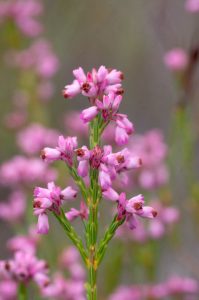Erica corifolia is commonly known as the Dark-tip Heath. This is a reference to the pink flowers, which quickly fade from purplish to blackish brown at the tip soon after opening. But it does not stop there, for the whole flower quickly loses its colour and turns brown. This does not sound a good scenario for producing a beautiful display of fynbos, yet Erica corifolia is one of stalwarts to colour the fynbos. It manages this because, like the everlasting daisies, the colour in bloom is not provided primarily by the flowers but but the calyx and bracts that surround each flower. In Erica corifolia, these are a deep pink, just like the flower when it first opens, but they retain their colour long after the flower has faded to brown. Indeed, the faded blackish flower helps to accentuate the colourful calyx and bracts and the common name underlines the prominence of this feature.
Erica corifolia is one of the commonest species in the mountain fynbos of the south-western Cape. It can often dominate areas and is very noticeable thanks to its bright pink colour that last many months. Not surprisingly it is also very variable too with a variety of forms, both in size and colour. What appears to be a white form of this species grows on the northern slopes of the Klein River Mountains. The most relevant characters for recognising the species, apart from the corolla quickly fading to brown, is the way the small flowers, about 3-5mm long, are clustered towards the end of the branches and the calyx and bracts are like petals. The plants are also single-stemmed, which help to separate it from a similar widespread species, which resprouts after fire, Erica articularis.
Colourful pink bracts and calyx are not unique to Erica corifolia. In the eastern Klein River Mountains and towards Napier there occurs another similar species, Erica vogelpoelii. The rather long name comes from Louis Vogelpoel, a Cape Town cardiologist who spent his spare time hunting ericas and orchids around the Cape mountains. Erica vogelpoelii shares many characters in common with Erica corifolia but has denser elongated heads of larger flowers, 6-7mm long, which are a deeper pink colour. These top even taller thinner wiry plants, so that the flowers often protrude above the surrounding fynbos. An effect that looks very impressive on the upper slopes of Phillipskop. The distribution of Erica vogelpoelii is more limited than Erica corifolia but there still appears to be quite some variation. The original description is from near Napier and the plants at Phillipskop have some notable differences (e.g. hairy stems, as opposed to non-hairy stems). But in many ways this just emphasises the challenge of applying correct names in the world of Cape heaths. At some point, these variations have to be regarded as part of the same variable species or split into many individual different species. Fortunately, it does not affect how beautiful these plants are in late summer on the slopes of the Klein River Mountains.
There are also two other species in the Klein River Mountains that are similar but smaller. The daintiest of these is Erica tenuifolia, which does indeed look rather like a miniature Erica corifolia. The plants get no taller than about 20cm and fewer flowers are held on the branch tips. The key difference though is in the leaves, which are held in pairs up the stem, as opposed to Erica corifolia where they are in a whorl of three at each node. Erica tenuifolia is rare at Phillipskop on steep upper slopes. Erica rhopalantha is intermediate between Erica corifolia and Erica tenuifolia. The flowers are also clustered at the end of thin branches but the plant is short and bushier than than Erica corifolia, and the corolla tube appears more globular. However, unless they are growing in close proximity, it can be sometimes hard to distinguish these two species.













